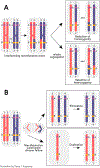Decreased copy-neutral loss of heterozygosity in African American colorectal cancers
- PMID: 32293075
- PMCID: PMC8045478
- DOI: 10.1002/gcc.22851
Decreased copy-neutral loss of heterozygosity in African American colorectal cancers
Abstract
Despite improvements over the past 20 years, African Americans continue to have the highest incidence and mortality rates of colorectal cancer (CRC) in the United States. While previous studies have found that copy number variations (CNVs) occur at similar frequency in African American and White CRCs, copy-neutral loss of heterozygosity (cnLOH) has not been investigated. In the present study, we used publicly available data from The Cancer Genome Atlas (TCGA) as well as data from an African American CRC cohort, the Chicago Colorectal Cancer Consortium (CCCC), to compare frequencies of CNVs and cnLOH events in CRCs in the two racial groups. Using genotype microarray data, we analyzed large-scale CNV and cnLOH events from 166 microsatellite stable CRCs-31 and 39 African American CRCs from TCGA and the CCCC, respectively, and 96 White CRCs from TCGA. As reported previously, the frequencies of CNVs were similar between African American and White CRCs; however, there was a significantly lower frequency of cnLOH events in African American CRCs compared to White CRCs, even after adjusting for demographic and clinical covariates. Although larger differences for chromosome 18 were observed, a lower frequency of cnLOH events in African American CRCs was observed for nearly all chromosomes. These results suggest that mechanistic differences, including differences in the frequency of cnLOH, could contribute to clinicopathological disparities between African Americans and Whites. Additionally, we observed a previously uncharacterized phenomenon we refer to as small interstitial cnLOH, in which segments of chromosomes from 1 to 5 Mb long were affected by cnLOH.
Keywords: African American colorectal cancer; The Cancer Genome Atlas; copy number variation; copy-neutral loss of heterozygosity; genotype and microarray data.
© 2020 Wiley Periodicals, Inc.
Figures




Similar articles
-
Lack of APC somatic mutation is associated with early-onset colorectal cancer in African Americans.Carcinogenesis. 2018 Dec 13;39(11):1331-1341. doi: 10.1093/carcin/bgy122. Carcinogenesis. 2018. PMID: 30239619 Free PMC article.
-
Copy neutral loss of heterozygosity (cnLOH) patterns in synchronous colorectal cancer.Eur J Hum Genet. 2021 Apr;29(4):709-713. doi: 10.1038/s41431-020-00774-w. Epub 2020 Dec 2. Eur J Hum Genet. 2021. PMID: 33268847 Free PMC article.
-
Increased frequency of 20q gain and copy-neutral loss of heterozygosity in mismatch repair proficient familial colorectal carcinomas.Int J Cancer. 2012 Feb 15;130(4):837-46. doi: 10.1002/ijc.26093. Epub 2011 Jul 15. Int J Cancer. 2012. PMID: 21445971
-
Colorectal cancer and race: understanding the differences in outcomes between African Americans and whites.Med Clin North Am. 2005 Jul;89(4):771-93. doi: 10.1016/j.mcna.2005.03.001. Med Clin North Am. 2005. PMID: 15925649 Review.
-
Disparities in colorectal cancer in African-Americans vs Whites: before and after diagnosis.World J Gastroenterol. 2009 Aug 14;15(30):3734-43. doi: 10.3748/wjg.15.3734. World J Gastroenterol. 2009. PMID: 19673013 Free PMC article. Review.
Cited by
-
Racial disparities in colorectal cancer clinicopathological and molecular tumor characteristics: a systematic review.Cancer Causes Control. 2024 Feb;35(2):223-239. doi: 10.1007/s10552-023-01783-y. Epub 2023 Sep 9. Cancer Causes Control. 2024. PMID: 37688643 Free PMC article.
-
Loss of Heterozygosity in Pediatric Acute Lymphoblastic Leukemia and Its Prognostic Impact: A Retrospective Study.Cancers (Basel). 2025 Jul 29;17(15):2500. doi: 10.3390/cancers17152500. Cancers (Basel). 2025. PMID: 40805197 Free PMC article.
References
Publication types
MeSH terms
Grants and funding
LinkOut - more resources
Full Text Sources
Medical
Research Materials
Miscellaneous

